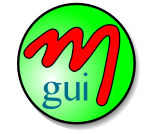Updated for version: mgui-1.0.21-alpha
|
Table of Contents
|
Introduction
The Tools Panel provides a convenient interface through which to access 2D and 3D tools allowing the user to directly interact with shape or data models via mouse or keyboard input. The panel is divided into categories based upon functionality. These categories and the tools they contain are described below.
View 2D
These tools allow the user to change the viewing parameters of their 3D graphics windows.
Dynamic zoom/pan
This allows the zoom and origin of any 2D window to be defined interactively, by mouse actions. It is the default tool of a 2D window. Panning is performed with a left-drag of the mouse. Zooming is controlled by a Ctrl-left-drag, or by scrolling the mouse wheel.
View 3D
These tools allow the user to change the viewing parameters of their 3D graphics windows.
Dynamic zoom/pan
This allows the line-of-sight, up vector, and zoom of a 3D window to be defined interactively, by mouse actions. It is the default tool of a 3D window. The orientation of the view is controlled by left-dragging. The zoom of the window is controlled by Ctrl-left-drag, or by scrolling the mouse wheel. The target point of the 3D window (i.e., offset from the center of rotation) can be controlled by Shift-left-drag, or by dragging with the mouse wheel pressed.
Query 2D
These tools allow the user to query their 2D graphics windows, or the objects they contain.
Polyline Ruler
The 2D polyline ruler allows you to measure distances along a polyline defined by mouse clicks. Clicking the tool's button will open a dialog box that provides output for each click: one value for the line segment ( d(seg) ), and another for the cumulative distance along the line ( d(cum) ). Values can be copied from selected cells of the table using Ctrl-C. The current polyline can be terminated either by double-clicking, or by pressing the Esc key. Closing the dialog box will deactivate the tool. The 2D ruler tool is straightforward to use, and is illustrated in this screenshot:

Draw 2D
These tools allow the user to create 2D shapes using the mouse, keyboard, or existing shapes.
Create closed polygon
This creates a closed 2D polygon object, associated with a particular section of a section set. The polygon is defined by successive left mouse clicks on the 2D window. Double-clicking will finalize the shape and add it to the section set. If the section set is visible in 3D (i.e., 3D.Show is true), the polygon will also be visible in the 3D window.
Create open polygon
This is same as above, but the polygon is not closed after double-clicking (i.e., it is a polyline).
Get convex hull of pointset
This computes a convex hull for the 2D point set (or shape) selected by a left mouse click. The hull is created as a new 2D polygon associated with the corresponding section set.
Draw 3D
These tools allow the user to create 3D shapes using the mouse, keyboard, or existing shapes.
Create mesh from polylines
This allows the user to create a mesh by specifying a set of polylines. The polylines must be contained in the same section set, and the algorithm determines vertex correspondence based upon their relative orientation. Note: this is very experimental, and hasn't been updated in a while.
Get mesh intersection polylines
This tools allows the user to define two 3D meshes, and computes a 3D polyline or set of polylines defining where these meshes intersection one another.
Edit 2D
These tools allow the user to edit or manipulate 2D shapes in their graphics windows, using mouse or keyboard inputs, or other means.
Edit 3D
These tools allow the user to edit or manipulate 3D shapes in their graphics windows, using mouse or keyboard inputs, or other means.
Cut mesh with plane
This allows the user to define a plane (from a section set) and a mesh, and cuts the mesh into parts where the plane intersects it. The parts are stored as new 3D mesh shapes, in a specified Shape Set.
Select vertices with polygon
This selects all vertices which lie within a polygon defined by manually selecting vertices on the mesh. The vertices must form a closed polygon on the surface; otherwise all vertices will be selected. Use of this tool is demonstrated in this tutorial:
Select mesh boundary vertices
This selects all vertices from a mesh which lie along its boundary. For a closed mesh with no holes, this will select no vertices.
Select mesh region boundary vertices
This allows the user to define the boundaries of a mesh region, defined by an integer vertex data column (with or without a name map).






